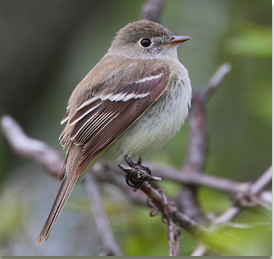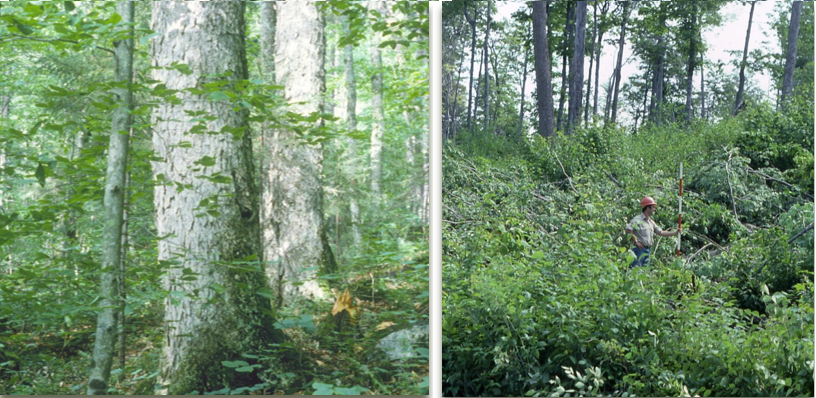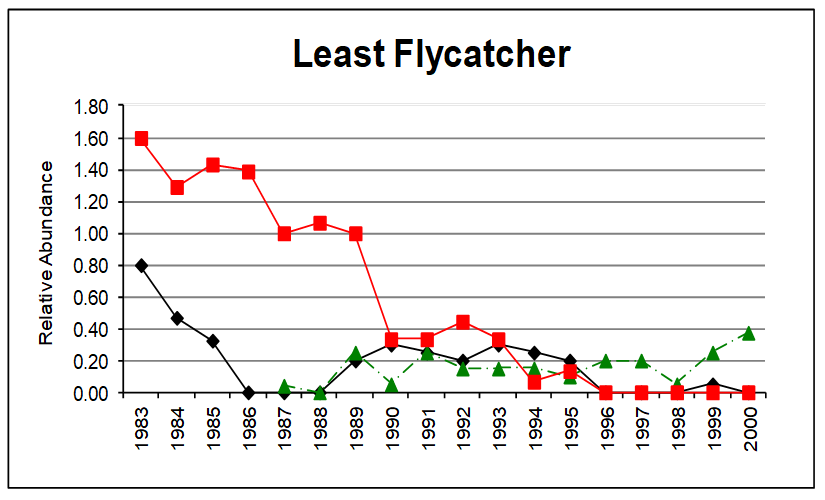Featured Data
Adirondack Long-Term Ecological Monitoring Program: Songbird surveys (1952 – 1964 and 1983 – 2008)
September 1, 2018
Susanne Grossman-Clarke
Citation
McNulty S. 2018. Project No. 2, Breeding Birds by Adirondack Ecological Center of the State University of New York, College of Environmental Science and Forestry, Newcomb, New York. Environmental Data Initiative. https://doi.org/10.6073/pasta/60258aef9640cc5eba87f0c767f4560f.
Description
Songbirds are diverse, abundant and relatively easy to detect, making the taxonomic group useful for understanding changes related to forest change. Declines in neotropical migrants have been linked to changes in habitat quantity and quality across species’ range. Yet songbirds that nest and forage in different habitat types or at different heights in the forest canopy may not be affected equally by forest change or management. The study objectives were to (1) Document long-term trends in relative abundance and diversity of breeding forest birds (songbirds) in forest stands with different harvest histories and management regimes and (2) Identify bird species that can be used as indicators of habitat change or degradation. We detected breeding songbirds using point-counts at Huntington Wildlife Forest (HWF) in the central Adirondack Mountains of New York during 1952-64 (Webb et al. 1977) and 1983-present. Relative abundance (RA, the number of individual birds/count) was measured in sites with differing management histories.

Sites include an unmanaged, 400 ha, >300-year-old stand called the Natural Area, a stand cut with the shelterwood/overstory removal method just prior to sampling in 1983, and several others. Nearly one hundred bird species were detected during the study duration. This region of the Adirondack Mountains has had little to no development or fragmentation, making it an excellent place to observe environmental patterns and change.

Results
In addition to tracking bird-habitat relationships at the local level, analyses based on life-history traits provide insights into the broader avian community. Trends for bird species breeding in the “old growth” Natural Area were investigated using the dataset from 1954 until 2000 and compared to Breeding Bird Survey (BBS) route data (McNulty et al. 2008). Trends for 22 species were negative, eight were positive, and one was zero; 20 were significant. Nearly all (15 of 17) long-distance migrants declined, whereas just 50% (7 of 14) short-distance migrants and permanent residents declined. Most (74%) Natural Area species, despite differences in sampling periods and local habitat features, matched in sign of trend when compared to Adirondack BBS route trends. The agreement in population trends suggests that forest interior birds, especially long-distance migrants, are affected more by regional than local factors.

References
McGee, G. G., D. J. Leopold, and R. D. Nyland. 1999. Structural Characteristics of Old-Growth, Maturing, and Partially Cut Northern Hardwood Forests. Ecological Applications 9:1316–1329. https://doi.org/10.1890/1051-0761(1999)009[1316:SCOOGM]2.0.CO;2.
McNulty, S.A., S. Droege and R.D. Masters. 2008. Long term trends in breeding birds in an old-growth Adirondack forest and the surrounding region. Wilson Journal of Ornithology. 120:153-158. https://www.jstor.org/stable/20456116.
Webb, W.L., D.F. Behrend, and B. Saisorn. 1977. Effects of logging on songbird populations in a northern hardwood forest. Wildlife Monograph 55:4-35. https://www.jstor.org/stable/3830404.